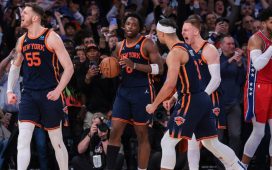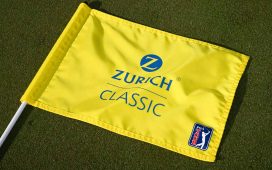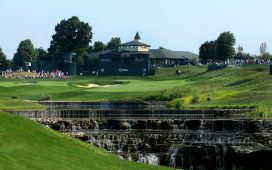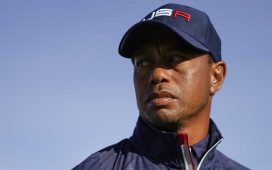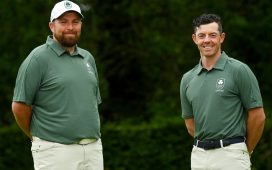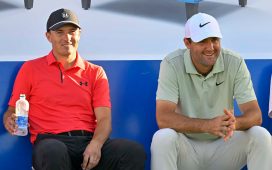Ensuring his children got a top education was a priority for Jay Edwards.
After all, Edwards’ father was a dentist. Edwards’ grandfather, a physician, made house calls on horseback in New Jersey before anyone envisioned the Garden State Parkway.
Jay Edwards was pushed to graduate high school at age 15, before heading to the University of Pennsylvania and becoming a dentist. He met his wife, Natalie, at the Ivy League college.
So after serving in the Army during the Korean War and opening a practice in Wethersfield, Connecticut, he and Natalie raised their four children with the goal of getting them a great education so they could attend the colleges of their choice.
In the end, three of the Edwards children matriculated, leading to successful professional careers.
The challenging second child
Then there was their second child, Bruce, who Edwards went to pick up the first day of kindergarten.
“All the kids came out,” Edwards told author John Feinstein, “except for Bruce. I waited a little bit, and still no Bruce. Finally, I turned to one of his friends who was leaving and said, ‘Where’s Bruce?’ He said, ‘Brucie bad boy.’ … Little did I know, it was just the beginning.”
It began a challenging relationship many children might relate to on Father’s Day.
“Bruce was always pushing the envelope,” Jay Edwards, 92, a widower who has lived in Vero Beach since 2000, told me the other day. “He caused more gray hairs on my head and his mother’s because of all his shenanigans.”
While Bruce didn’t get in serious trouble — he’d accept a dare now and then from schoolmates, his father said — he didn’t meet high parental standards in school.
“He had the attention span of a flea,” Jay said. “He had a high IQ; he was a pain in the (you know what) to a lot of his teachers.”
Even in parochial and private schools, Jay said.

Tom Watson hugs caddie Bruce Edwards after winning the 1982 U.S. Open.
Finding a passion at Wethersfield CC
At age 10 or 11, though, Bruce found a passion — even if only for a few months a year.
The Edwardses had joined Wethersfield Country Club, which had one of the best youth caddie programs in the nation. It was so good, Jay said, the PGA Tour agreed to use youth caddies during its annual tournament there in the 1960s.
Bruce became one of those caddies, eventually carrying Dick Lotz’ bag at the Greater Hartford Open a few times, Jay said.
Bruce’s younger brother, Brian, also caddied at Wethersfield most summer weekends. It was hard work carrying two bags at a time for 18 holes in the morning, then going back for two more in the afternoon.
“You were whipped, but you felt like you were rich,” said Brian, noting he and his brother could get $2 to $5 per bag per round.
On Sundays after their rounds, the family had dinner watching the final holes of that week’s PGA event on TV.
Jay and Natalie were happy they and Bruce had a common love for golf, but school had to take priority. After all, said Gwyn Dieterle, the youngest Edwards daughter, her father was old school and driven.
“Bruce was always going to be a rebel and do what he wanted to do,” said Gwyn, noting he loved time with his friends. No one told him what to do, where to be or what to study.
While their firstborn headed to a top university en route to becoming a Naval intelligence officer, the Edwards knew getting Bruce through high school would be a struggle, Jay said.
College? Next stop the PGA
Instead of going to college after graduation, Bruce and his friends looked for caddie jobs at PGA events, making peanuts. Jay and Natalie were concerned their son was traveling on limited means from tour stop to tour stop.
“He was on the road a lot,” Jay said, noting one time Bruce called from Texas to say he’d be on the sideline of college football’s Cotton Bowl holding an audio dish. “He’d always land on his feet. … He never asked for money.”
Still, Jay said he and his wife hoped Bruce would get caddying out of his system and go to college. By the time Bruce was 19 in 1973, he started carrying the bag of a winless pro only five years older. The two hit it off.

Tom Watson holds his putter aloft and gets a handshake from his caddie Bruce Edwards after winning the fourth annual Memorial Tournament at Muirfield Village Golf Club in Dublin, Ohio, May 28, 1979. He finished the 72 holes at 3-under par 285. (AP Photo/Mark Duncan)
Meeting a young Tom Watson
Stanford-educated Tom Watson started the final round atop the U.S. Open leaderboard on Father’s Day 1974, before shooting a 79, without Bruce. Back then tournaments like the Open, and the Western Open, which Watson won (earning $40,000 a few weeks later), did not allow players to bring their own caddies.
The duo didn’t win their first tournament together until May 1975, also netting $40,000, with $2,400 going to Bruce. Watson, who would win 39 tournaments, including six majors, was becoming a star. It became clear to his family Bruce wasn’t going to give up the bag to go to college.
In Wethersfield, Sunday night dinners became more exciting.
“It was an event,” Gwyn said, noting her mom would make pasta and cover the TV trays in the den with newspapers. “It was nice to have somebody to root for.”
Brian also remembers those Sunday dinners.
“It was just kind of wild to see your brother on TV,” said Brian, who caddied on tour after college before deciding to go to dental school. “We’d always follow and see who (Bruce) was working for. It was kind of a way to keep tabs on him.”
On Father’s Day 1982, Watson won the U.S. Open, with a legendary chip in on the penultimate hole to cement a lead over Jack Nicklaus. After the round, Watson credited Bruce for his encouragement and putt reading.
Bruce and Tom were partners for most of the next 20 years. In 2002, Watson and friends detected a slur in Bruce’s speech. In January 2003, the Mayo Clinic in Minnesota diagnosed Bruce with Lou Gehrig’s disease, amyotrophic lateral sclerosis, which attacks nerves that control muscles. Life expectancy is two to five years.

Jay Edwards, 92, a retired dentist now living in Vero Beach, sits next to the Golf Writers Association of America’s Ben Hogan Award he accepted on behalf of his son Bruce Edwards, the longtime caddy for professional golfer Tom Watson. Bruce Edwards was honored with the award in 2004 while remaining active in the sport while suffering from amyotrophic lateral sclerosis, or ALS. Jay Edwards accepted the award for his son in April 2004 in Augusta, Georgia on the eve of the Masters tournament. By the following morning, Bruce Edwards had succumbed to his illness at the age of 49. (Photo by Patrick Dove/TC Palm/USA Today Network)
Parents learn about ALS diagnosis
Bruce had to make the trip to Vero Beach, with his new fiancé, to tell Jay and Natalie.
“All I could think was that I was going to break my parents’ hearts.” Bruce told Feinstein for his book, “Caddy for Life.”
Jay’s older sister and longtime Vero Beach resident Joan Walsh, who saw Bruce as a charming free spirit, was there in an effort to soften the blow. Over the years, Walsh and other family members came to think Bruce’s school challenges stemmed from an attention-deficit issue undetected in the early 1960s.
When Bruce told his parents about the ALS, Feinstein wrote, it was the first time he’d ever seen his father cry, inconsolably.
“We both knew exactly what ALS was and what it means to have the disease,” Jay told Feinstein. “I kept trying to get ahold of myself, but every time I thought about my son. …”

Tom Watson talks with his caddie Bruce Edwards on the par 3 15th hole during the third round of the Ford Senior Players Championship on July 12, 2003 at the TPC of Michigan in Dearborn, Michigan. Edwards died April 8, 2004 aged 49 after battling against a degenerative wasting disease since 2003. Edwards caddied for eight-time majors winner Tom Watson for more than 30 years. (Photo by Craig Jones/Getty Images)
Aging Watson’s U.S. Open hope
Bruce, however, wouldn’t give up. That Father’s Day weekend, he was on Watson’s bag as the 53-year-old golfer shot a 65 to lead the first round of the U.S. Open. He continued to carry Watson’s bag as long as he could, into November 2003.
In April 2004, Bruce was unable to travel to Augusta, Georgia, to receive the Golf Writers Association of America’s Ben Hogan Award, given annually on the eve of the Masters, his favorite tournament. The award honors a person in golf who remains active while overcoming adversity.
Jay accepted the award for his son.
“My son is a very brave man facing this terminal disease with dignity and courage,” Jay told the gathering, later telling interviewers his son had “courage” and “grace under the greatest pressure.”
By the next morning, Bruce had passed at age 49.
Watson pledged to find a cure for ALS. He and Feinstein created the Bruce Edwards Foundation, which has raised more than $6 million to fund the Robert Packard Center for ALS Research at Johns Hopkins and other efforts.
“Bruce’s legacy will go down as somebody who doesn’t have a mean bone in his body,” Watson told interviewers for a Golf Channel presentation of “Caddy for Life.” “He does things for the right reasons. He loved sport with a passion. He loved caddying more than anything else in his life.”
He was so good at it, he’s been considered one of the best ever, among a group who made caddying a true profession. Jim “Bones” Mackay, Phil Mickelson’s longtime caddie, called Bruce the Arnold Palmer of caddies.
In the end, Bruce got a great education. It just happened to be in an informal school his parents had never considered. But Jay and Natalie were successful in making sure Bruce had the values to become the best at what he did.
For the book, Jay told Feinstein:
“Who knows, if he hadn’t ended up with Tom Watson maybe he would have come home, but I’m not sure. He loved the life out there. He made lots of friends, good friends, and he really found a niche doing what he was doing. He was right, we were wrong. I’m really proud of what he has become.”
Nowadays, Jay is thankful for the efforts of Watson and Feinstein in the fight against ALS.
On Father’s Day, Jay likely will continue the tradition: watching golf and Zooming with his children. They visited him in May for the first time in 18 months after their COVID-19 vaccinations.
Bruce remains with Jay, too. He’s heartened when he sees Bruce’s name still mentioned in golf coverage.
“When you lose a child it never goes away,” he told me. “It violates the laws of nature.”
This column reflects the opinion of Laurence Reisman. Contact him via email at larry.reisman@tcpalm.com, phone at 772-978-2223, Facebook.com/larryreisman or Twitter @LaurenceReisman

